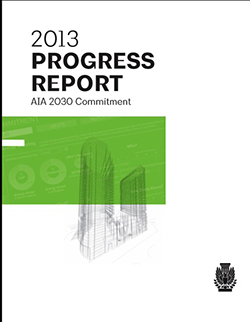Architects Get Closer to Carbon Neutral Goal
 WASHINGTON — The number of projects meeting a carbon reduction goal set by the American Institute of Architects (AIA) has surged 200 percent over the last two years, according to a new report from the AIA.
WASHINGTON — The number of projects meeting a carbon reduction goal set by the American Institute of Architects (AIA) has surged 200 percent over the last two years, according to a new report from the AIA.
Buildings consume more than 48 percent of the nation’s energy, according to AIA. Introduced in 2009, the AIA’s 2030 Commitment Program is a voluntary initiative for architecture firms and other entities in the built environment to commit their practice to advancing the AIA’s goal of carbon neutral buildings by the year 2030. The AIA released a report that shows how participating architecture firms are making progress toward that goal. Out of more than 260 firms that have made the commitment to create carbon neutral buildings, the AIA said 99 firms submitted reports for analysis, a 10 percent decrease from 2012.
The AIA’s analysis counted 2,462 projects for its 2030 Commitment 2013 Progress Report. The number of projects increased 150 percent from 2012. Out of those, 401 design projects are meeting the program’s 60 percent carbon reduction target. That’s a 200 percent increase from 2012.
The AIA said 1.6 billion gross square feet is represented in its 2013 data, which is a 9 percent increase from the year before. More than 60 percent of that total gross square feet uses energy modeling, a process of estimating the energy usage of a building, to predict operation energy consumption. The AIA recommends energy modeling, as it improves projected project performance by an average of 8 percent.
For interiors-only work the AIA 2030 Commitment measures designed lighting power density (LPD). Generally, the ability of an interior design project to affect a building’s energy is limited to lighting design. The LPD metric is the sum of wattage required for all lighting equipement divided by project area. AIA’s report found a 19 percent average firm reduction in LPD for interior projects — an increase of 2 percent over 2012.
The AIA 2030 Commitment uses the term predicted energy use intensity (pEUI), which measures the energy that can be assumed based on the project’s design, to differentiate from actual operational (metered) energy use. The AIA report found a 34 percent average pEUI reduction reported by firms, a 3 percent decrease from 2012.
The AIA also reported that 7 percent of total gross square feet is meeting the 60 percent carbon reduction rate, a decrease of 7 percent from 2012.
“There is some very encouraging data in this report that shows how architects are making measurable progress towards reducing the carbon emissions in their design projects,” said Robert Ivy, FAIA, AIA chief executive officer, in a statement. “But one of the major findings from our research is that in order to maximize the energy efficiency of buildings and to realize our ultimate goal of carbon neutral buildings, energy modeling must become a standard part of the design practice.”
The AIA said in a press statement that the decrease in firms reporting data is mainly attributed to the time and effort involved in tracking and entering project data. To address that situation, the AIA has partnered with the Department of Energy to create the 2030 Design Data Exchange to provide a more user-friendly interface and allow firms to anonymously research how their projects are predicted to perform compared to similar projects in the AIA 2030 Commitment portfolio. This new reporting tool will be made available in late December 2014 or early January 2015.
